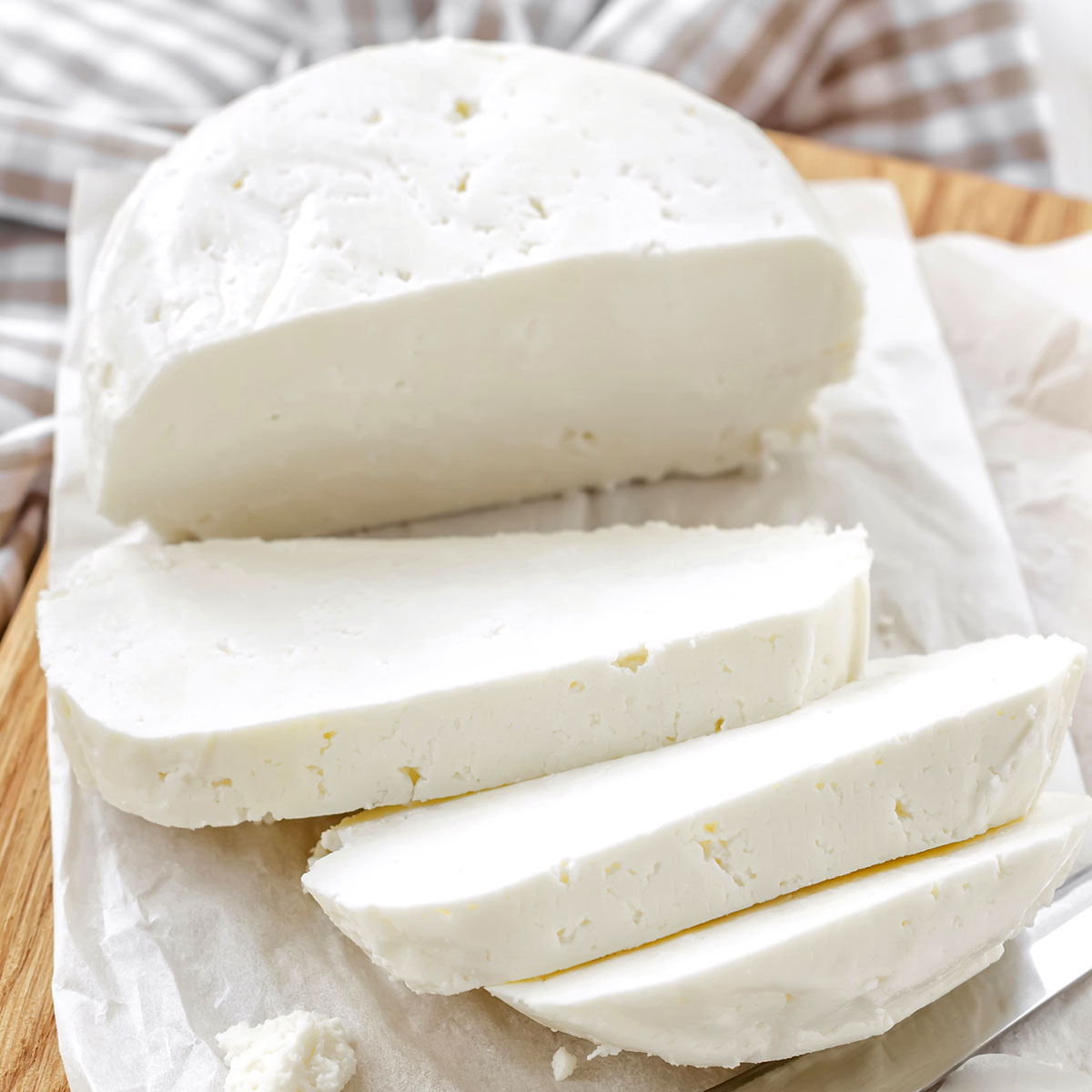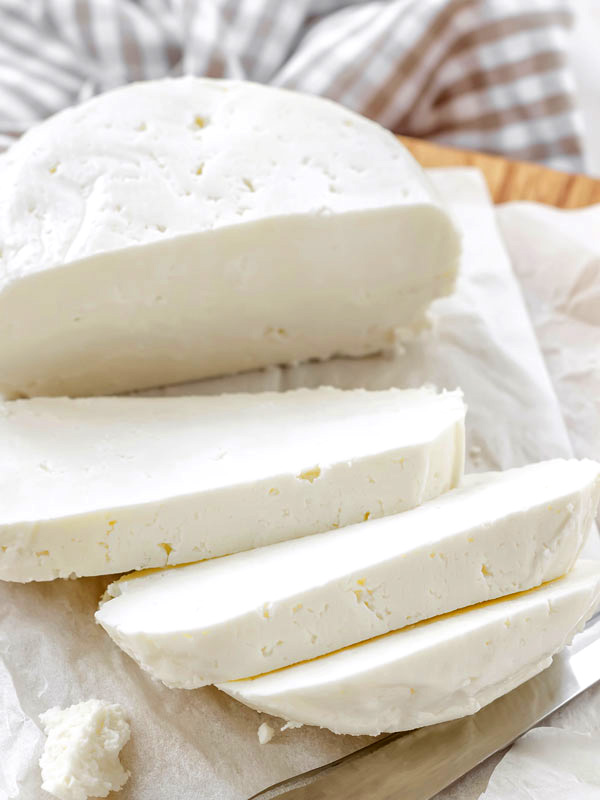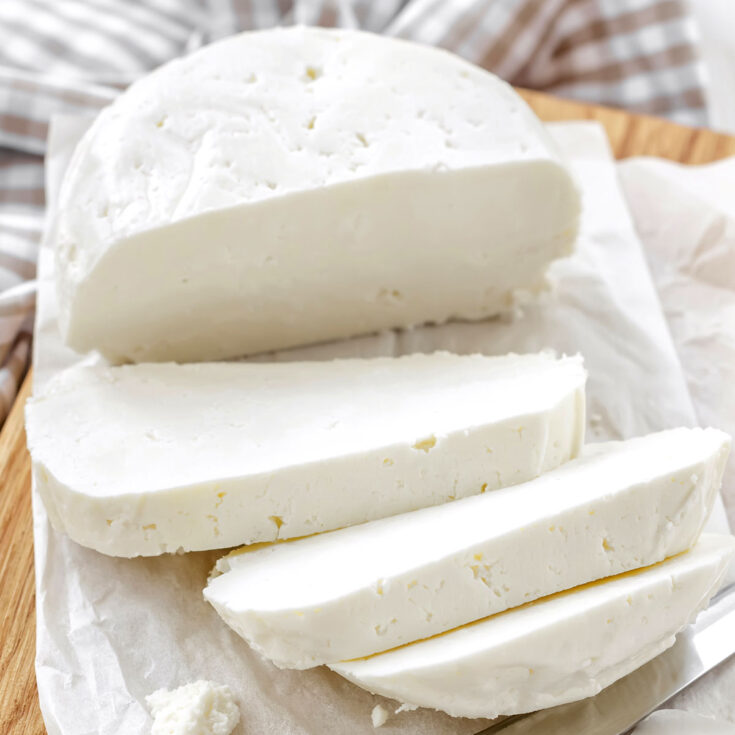Twaróg
Twaróg: Polish Farmer’s Cheese
How to pronounce it?
tfa-roock
‘Play’ to hear:

Twaróg (also known as Polish-style Farmer’s Cheese) is a type of white fresh cheese. It’s a firmer and drier variety of Quark – although the flavour is quite unique and it’s hard to compare it to any other cheese.
This cheese is essential to Polish cuisine, it’s a key ingredient of many classic dishes. It tastes best when fresh, and that’s why it’s hard to buy it internationally. Luckily, Twaróg can be made at home!
For the full list of ingredients & detailed instructions, please see the recipe card at the end of this post. But before you scroll, there’s important stuff to know below.
Twaróg is creamy, yet it keeps its shape and can be sliced. Depending on how it was made, it can be milder (sweeter) or more tart.
Here’s what happens under the hood: milk gets acidified with live cultures of bacteria and goes through a natural process of lacto-fermentation. First, milk turns sour. When warmed up gently, cheese curds start to form. Then we drain the excess whey, and we’re done.
Do you need any special ingredients or equipment to make this Farmer’s Cheese?
You’ll need one of the following:
- Raw Milk (unpasteurised, unsterilised),
or… - A combo of regular, pasteurised whole milk AND fresh, cultured sour cream.
To learn more about these ingredients and where to get them, have a look at this Soured Milk post (everything is outlined there).
Equipment-wise, a kitchen thermometer would be really useful, especially when making Farmer’s Cheese for the first time.
What dishes can you make with this Twaróg Cheese?
Polish-style Farmer’s Cheese is often enjoyed on its own – sliced and served on a piece of rye bread. Most popular options are:
- Twaróg sprinkled with salt and fresh chives, garnished with slices of red radish, or…
- Twaróg sweetened with a generous dollop of honey. Some prefer fruit preserves instead.
As an ingredient, this Farmer’s Cheese goes into many classic Polish dishes, including (but not limited to):
- Breakfast bread spreads/pastes
- ‘Gzik’ – a creamy dip, mixed with cumin, spring onion and dill.
- Various fillings, e.g. for Sweet Cheese Pierogi, for Potato and Cheese Pierogi, or for ‘Naleśniki’ (Polish-style crêpes)
- An array of desserts: Cheese Yeast buns (‘Drożdżówki’), Cheese Babka, Cheesecakes, Easter Pascha
- Dough for dumplings (e.g. ‘Leniwe’ dumplings)
Can you make this Farmer’s Cheese another way?
Kind of, but not really.
In this recipe, milk goes through the process of culturing (lacto-fermentation). It takes time – but the end result is worth the effort. It’s not only about the flavour, but also about health. Your gut will thank you for all these friendly bacteria.
There are many quicker recipes, using lemon juice and/or vinegar to curdle the milk. In my view, these recipes shouldn’t be referred to as ‘Twaróg’ at all. That’s because the end result is very different. Cheese made this way will be closer in texture to Indian Paneer (recipe here) or Queso Blanco.
Don’t get me wrong, these cheeses are great too. But they’re chewier and more firmly set, quite different from our good old Polish-style Farmer’s Cheese.
Note: there’s another good recipe using cultured buttermilk, I’m hoping to test it and write about it soon.
What diets is this Farmer’s Cheese suitable for?
Farmer’s Cheese is suitable for vegetarians and those who follow a gluten-free diet. It’s perfect for low-carb/keto diets as well.
How long can you keep this Farmer’s Cheese in the fridge?
Farmer’s Cheese loses freshness very rapidly, so it’s worth making (or buying) smaller pieces at a time.
Twaróg absorbs other smells easily. To prevent that from happening, store the cheese in a container, tightly covered with a lid. Refrigerate for a maximum of 4-5 days. It tastes best at its freshest, so hurry up!
Can I freeze this Farmer’s Cheese?
I wouldn’t recommend it. In my experience, freezing changes Twaróg’s texture dramatically. It turns dry and crumbly, sometimes even tough.
Freeze the end product instead – may it be Cheese Pierogi, Polish-style cheesecake and more. You’ll find more detailed freezing instructions with every recipe.

Twaróg: Polish Farmer's Cheese

Twaróg is soft and milky, with a mild taste.
This recipe makes approx. 1 pound (450 g) of Farmer’s Cheese. If you’re planning on making Sernik (Polish-style cheesecake), double the ingredients.
Ingredients
- 2 qt (2 litres / 8 cups / roughly 0.5 gallon) whole milk, pasteurized - or raw milk (see notes)
- 8 tsp sour cream, natural, cultured
Instructions
Souring the milk:
- Gently warm up the milk on the stove. By “gently”, I really mean it! Aim for a slightly warm (not hot!) temperature.
- If you’re using raw milk, sometimes a layer of thick cream forms on top - keep it or remove it (I love full-fat everything, so personally I keep it; but if you’re avoiding fats - get rid of it). When using raw milk, no sour cream is needed. Just proceed to Step 5.
- When using pasteurized milk from a store, add 8 heaped teaspoons of sour cream (or more!) per 2 quarts (roughly 2 litres) of milk.There is no need to measure the ingredients exactly, it will work either way.
- Blend milk and sour cream together with a fork.
- Pour the milk mixture into a large container, ideally a large cooking pot - that way we won’t have to transfer that milk later on.
- Cover the container (that’s optional). Some homecooks leave the container uncovered, others cover it with a cheesecloth to keep the insects away. I use a piece of a muslin square and secure it in place with a rubber band.
- Leave the milk in a warm place, for example: on the kitchen counter. Don’t stir it, don’t poke it - just let it be.
- The fermentation process can take anywhere from a few hours, up to 2 days. That depends on the temperature: if you live in a hot climate, it’s likely to be ready within a day. For me, it took a day and a half to curdle.
- Observe the milk, have a taste from time to time. Once it has curdled, the consistency turns jelly-like and the flavour becomes pleasantly sour - it’s ready. The longer you wait, the more sour the milk (and therefore eventually: the cheese as well) becomes.
- Carefully move the curdled soured milk into a cooking pot, try not to break the curd too much. If you soured the milk in a cooking pot from the get-go - just keep it there.
- Submerging the knife into the curd, cut it into large cubes, roughly 2 inch in size.
Making the cheese:
- Start heating the mixture on a ‘low’ heat. Slowly, gently. If you have a thermometer, aim for the 97-102°F (36-39°C) range in the centre of the pot.
- While heating, gently stir the ingredients from time to time. Start from the edge and then move to the center of the pot. Aim to keep the same temperature for 30 minutes, up to an hour.
- After that time, let the mixture cool completely (2-3 hours are usually enough)
- Place a strainer over a large bowl, to collect the strained whey. Layer it with a cheesecloth (I'm just using clean muslin squares). Pour the curled mixture in.
- Squeeze off the excess whey. Make a knot and hang to drain for 30-40 minutes.
- After draining, you can make it even dryer by pressing it. Just put something heavy (e.g. a jar filled with water) on top of the cheese wrapped in a cloth. The resulting Twaróg will be firmer and more compact.
- Refrigerate until you're ready to use it.
Notes
- There is no need to measure the ingredients exactly, just eye-ball it. Here's a rule of thumb: you need roughly 1 heaped teaspoon of sour cream per 1 cup (250 ml) of milk.
- Reminder: a shelf-stable UHT (Ultra-Pasteurized) milk won’t work! It will turn bitter.
- If you’re using fresh, raw milk - no sour milk is necessary. Just up the milk volume to 0.6 gallon (2.3 litre) and follow the recipe ‘as-if’ the sour cream is already there.
- When making this Twaróg, I followed the tips from Pracownia Serów and Kukbuk magazine.
Nutrition Information:
Yield:
4Serving Size:
1Amount Per Serving: Calories: 111Total Fat: 5gSaturated Fat: 3gTrans Fat: 0gUnsaturated Fat: 2gCholesterol: 20mgSodium: 98mgCarbohydrates: 10gFiber: 0gSugar: 0gProtein: 7g
Polonist is reader-supported. When you buy through links on our site, we may earn a small affiliate commission. Learn more
Recipe Information
Filed under:
Alternative traditional/regional names:
Ser Biały, Krajanka
Also known / Misspelt internationally as:
Polish Quark, Polish Cottage Cheese, Polish Farmer Cheese, Farmer's Cheese, Polish Pot Cheese, Twarog, Tvorog, Tvoróg, Ser biali, Ser bialy, Ser biay, Ser baliy
Tested by:
First published on:
Recipe by / Adapted from:
Story by:
Bibliography / References: